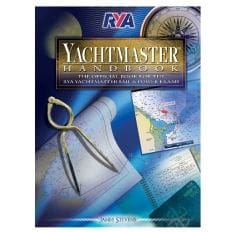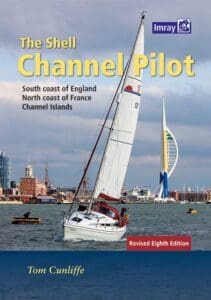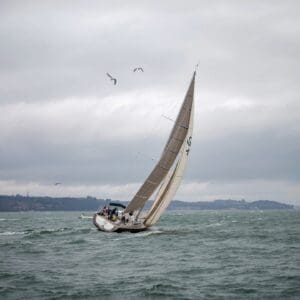Bridging the Gap: A Coastal Skipper’s Review of the RYA Yachtmaster Handbook
If you’ve been sailing for a while, you’ll know there’s a very particular gap between where the mental journey to Day Skipper ends and the one to Coastal Skipper/Yachtmaster begins. It’s a gap filled with confidence questions:
- “Could I handle this in 30 knots?”
- “What if I get the tide wrong at this headland?”
- “Would I be comfortable running a night watch on my own?”
I’ve seen it many times – competent, capable skippers who still feel like they’re one tricky passage away from being out of their depth. The RYA Yachtmaster Hanbook has been my go to since it was published in 2013, which is why I was genuinely pleased to find they had reprinted it last year and even more pleased to be given the chance to review it.
This isn’t just a manual for those planning to sit the Yachtmaster exam (though it does that job very well), it’s also an excellent “bridge” resource for anyone who’s mastered day sailing and wants to expand their range – whether that means crossing the Channel, tackling areas with stronger tides, or just feeling at ease in heavy weather.
First Impressions
The Yachtmanster handbook is smartly presented – with full-colour diagrams, clear tables, and plenty of photos to illustrate both good practice and common mistakes. The layout makes it particularly useful to dip into specific topics, but the book also reads well cover-to-cover, with each chapter building logically on the last.
What really stood out for me when I first got it, it is how the content has been refreshed to reflect modern sailing – there’s as much on electronic navigation as there is on paper charts, without neglecting the fundamentals. Stevens clearly understands that today’s Yachtmaster candidate, or aspiring coastal skipper, will often be using a mix of both.
Stevens has woven in some important changes and refinements:
- Electronic Navigation Integration – GPS, plotters, and apps are now presented as essential tools, not optional extras. There’s sensible guidance on integrating electronic fixes with traditional dead reckoning and pilotage techniques.
- Heavy-Weather Tactics – Expanded sections on storm sails, heaving-to, running off, and choosing the right strategy for your boat and crew. This is gold for the confidence gap sailor – heavy weather is rarely about heroics and often about preparation and pacing.
- Collision Regulations Update – The latest IRPCS changes are clearly explained, with worked examples and diagrams that make the “rules of the road” much easier to apply in real time.
- Passage Planning Emphasis – More detail on planning for tidal gates, weather windows, and ports of refuge, with examples that feel relevant to both UK and near-coastal cruising grounds.
Strengths of the Book
- Practical Examples – The book is peppered with case studies and “what would you do?” scenarios that challenge you to apply the concepts.
- Clear Diagrams – From collision avoidance to tidal curves, the visuals are clear and logically laid out.
- Exam Insight – For those actually aiming for Yachtmaster, Stevens offers exam tips and common pitfalls without turning the book into a test crammer.
- Balanced Tone – Encouraging but realistic. He doesn’t gloss over the fact that skippering at this level demands judgement and preparation.
A Few Things to Note
- UK-Centric Examples – This is inevitable given the RYA focus, but the tidal examples and weather references are firmly rooted in the British Isles. For overseas readers, the principles still apply, but the local flavour is very much Solent/Channel-oriented.
- Not for Absolute Beginners – While it’s accessible, you’ll get the most from it if you already have at least Day Skipper knowledge and some coastal miles under your belt.
Who Will Benefit Most
- Day Skippers eyeing the Coastal Skipper ticket who want to deepen their tidal, weather, and night navigation skills.
- Coastal sailors planning their first Channel crossing and looking for a structured way to assess passage plans, weather, and watch systems.
- Self-taught skippers who want to benchmark their methods against RYA best practice.
My Personal Take
I approached this review with the “confidence gap” theme in mind, and the Yachtmaster Handbook hits it squarely. For many skippers, the leap to longer passages is less about acquiring new information and more about gaining a framework for decision-making.
This book gives you that framework. It makes you think about contingency ports, about tidal stream versus leeway, about what “safe” actually looks like in a given set of conditions. The updated heavy-weather section is particularly valuable – not because you’ll go out looking for a gale, but because knowing how to handle one changes your mindset in every forecast.
How I’d Use It Aboard
If I were coaching someone toward their first coastal passage beyond the horizon, I’d recommend this book as both a study guide and a cockpit reference:
Before a trip, use it to walk through:
- The passage plan process – including “what if” scenarios for weather and tides.
- Night nav techniques – lights, buoys, radar overlays, and collision avoidance in darkness.
- Crew and watch planning – making sure everyone knows their role before the lines are cast off.
During the passage, use it as a ready reference.
Then, after the passage, compare what you actually experienced to the scenarios in the book. Next time those lessons will come alive most because you’ll have a frame of reference.
If you are coaching, it’s a great debrief tool too.
Final Verdict
The RYA Yachtmaster Handbook is far more than an exam prep manual – it’s a practical companion for any skipper stepping up from day sailing to real coastal command. It’s written with authority but without arrogance, and it balances tradition with modern tools in a way that feels entirely current.
If you’re somewhere between confident day sailor and aspiring coastal skipper, this book could be the catalyst that makes you start planning those longer, more adventurous passages – with the skill and confidence to enjoy them.
Fair winds,
Chris


